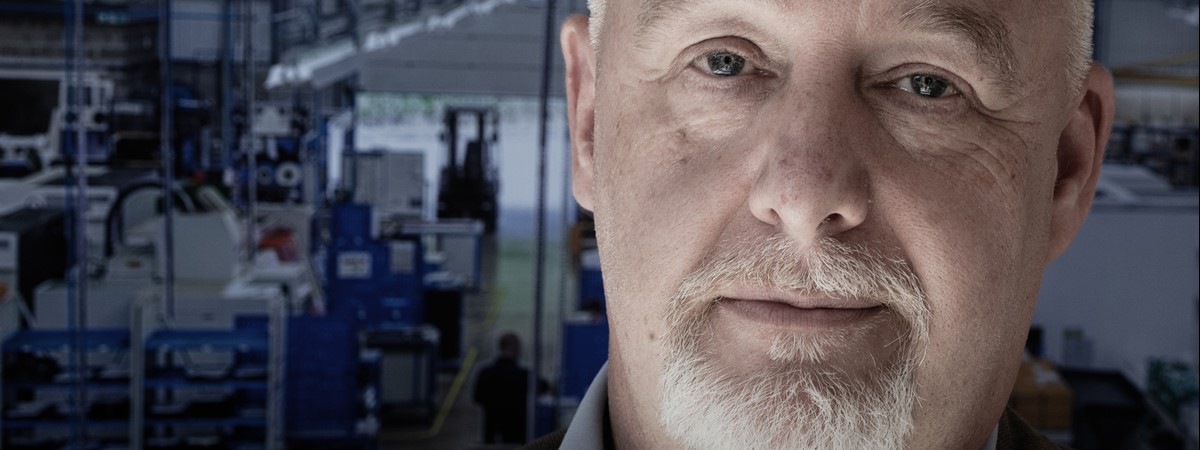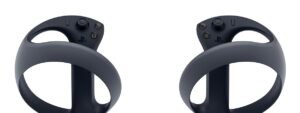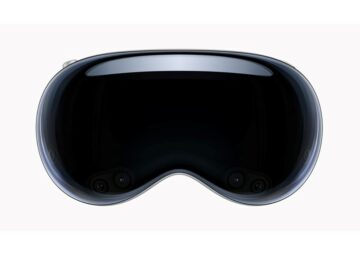Executive director of the Institute of Digital Engineering and Autonomous Systems Dr Andy Levers discusses how industry can collaborate with academic research in computing, robotics, AI, and virtual engineering systems.
We’re sitting in a conference room in the recently inaugurated Digital Innovation Facility (DIF), a £12.7m centre of excellence for emerging engineering technologies. Headed by Dr Andy Levers, DIF is a purpose-built environment to support collaborations and partnerships between academia and industry in the areas of computer and data science, robotics and engineering. Levers’ full title is executive director of the Institute of Digital Engineering and Autonomous Systems (IDEAS), which sits above DIF and the Virtual Engineering Centre in the organisational food chain. He says that DIF was set up to bring together a multi-disciplinary team of engineers, scientists and technologists who will use their expertise to “maximise the possibilities and impact of these emerging technologies”.
Based at the University of Liverpool, DIF’s facilities include a mixed-reality laboratory kitted out with the latest VR technology, an extreme environment lab that simulates real-world hazardous conditions for testing robotics and autonomous systems, as well as an immersive laboratory that focuses on developing sensory technologies in the areas of smell and touch for future ‘tactile internet’ applications.
In the hour we spend scratching the surface of what’s going on at DIF, I get to sit in the driver’s seat of a virtual train, see where drones are tested to their limits and walk around a multi-sensory virtual environment in which I get literally to smell the coffee, cookies and houseplants. It’s exciting stuff, and there’s a definite atmosphere of pent-up energy to innovate after a series of interruptions and delays caused by the Covid-19 pandemic. Levers’ role at DIF is to oversee “all strategic, operational and research initiatives”.
DIF formally opened its doors in May 2022 in a ceremony presided over by Liverpool City Region Metro Mayor Steve Rotheram. Also present was Sir Robin Saxby, tech entrepreneur and former CEO of semiconductor design giant Arm, who is currently a visiting professor at the university. Among the scripted soundbites, the legendary 75-year-old engineer recorded his thoughts in a discussion with Levers, in which he commented: “When I was a kid, I used to design chips with maybe 50 transistors on them, while today one of the start-ups I’m involved with is using as many as 40 million.” Saxby says there is a need for facilities like this, while being in Liverpool means DIF is “outward looking and globally connected. You don’t want to be stuck in an ivory tower.”
Levers explains that “at IDEAS we have a concise mission, which is to create transformation in industry through the translation of research into commerce to provide benefit”. It takes a bit of untangling, but of the two innovation centres to fall under the IDEAS umbrella, the Virtual Engineering Centre (VEC) has been operational for more than a decade with “an ‘industry first’ focus”. The new element to IDEAS – DIF – brings together existing university groups and laboratories, as well as new entrants into a single space, centred on the themes of autonomy and autonomous systems, hazardous environment > < simulation, and chemical-based material discovery through AI-based laboratory automation. Put simply, it’s a ‘Laboratory of the Future’ in which DIF is using machine learning in combination with mobile robotics to accelerate material discovery for use in applications from medical to fast-moving consumer goods.
With part of its mission to take innovation out into the industrial landscape, IDEAS has run a number of industrial digitalisation programmes designed to help SMEs adopt digital technology and understand how they can integrate digital into their business plans. It does this as part of a multi-stakeholder consortium that delivers “an ecosystem for manufacturers and other businesses to take advantage of the capabilities that exist within the facilities”.
The first project was LCR 4.0, which gave Liverpool City Region manufacturers access to digital expertise and technology. This “got a lot of traction locally and nationally”, and appeared in the government’s Made Smarter Review as a case study. It also created jobs: “Assessments done at the end of the three-year period indicated that it had created around a thousand jobs for the city.” Combined with three other projects, Levers says, “we will have assisted more than 800 SMEs. This isn’t a box-ticking exercise. We have to hit our targets. But really it’s all about the value we produce in terms of new products to market and delivering sustainable and resilient employment.”
Levers is equally enthusiastic about the technology under his roof, such as the drone testing taking place in the Extreme Environment Lab (which, to judge by the aircraft wreckage on one of the benches, would appear to live up to its name). “There’s been a lot of media attention about drone corridors and the delivery of medical supplies, particularly in remote areas, which drones are ideally suited for. There are similar plans being drawn up in Liverpool around various use-cases for drone applications.” The Extreme Environment Lab is already being put to use in various test and verification processes for bringing safe drone operation into the city.
“We need to have assurance that these operations can be conducted safely with minimal acceptable risk to property and people’s wellbeing. In an urban environment there are lots of hazards, particularly in a coastal area where you’ve got quite aggressive gulls at various times of the year. It’s a crowded environment and the opportunity for incident is there, which means there are risk assessments to be done as well as formal path verification. We’ve done a high-fidelity data capture of the city in its entirety down to a resolution of ±3cm, which can be used as part of the simulation to plan paths.” For the moment, says Levers, plans for drone deliveries in the medical sector would likely be restricted to operating between NHS facilities; another application might be remote air-quality monitoring.
‘Immersive environments are great places to make mistakes’
DIF has two zones for the practical application of virtual, mixed and immersive reality technologies. The Mixed Reality Lab has a multi-participant powerwall that can allow independent viewpoints for up to three people “with immersive sound that adds to the sense of presence, which is particularly useful in applications such as hazard awareness in factories environments or urban settings where you are using multiple senses to perceive the environment”. Another area of research at DIF aimed at increasing sensory immersion is the inclusion of senses such as smell and taste in virtual environments. These developments occur in the Immersive Lab, where the headset wearer can experience a blended sensation of (in one demonstration) filling a virtual cup of coffee while interacting simultaneously with a real one through the use of haptics and collaborative robotics.
You can (and I did) theatrically spill virtual liquid everywhere in the simulation, while creating no mess with actual liquid. The serious point here is that immersive environments are great places to make mistakes. “They are really good for collaborative design reviews, especially when teams are distributed geographically,” says Levers. “We can incorporate data feeds from other equipment such as virtual control panels and digital twins. Virtual environments offer huge possibilities for remote and collaborative working.”
In his mid-50s, Levers has spent most of his career in industry, including “a long time with Airbus in a variety of different roles”, where he was responsible for metal forming technologies: “A landmark was the industrialisation of the Creep Age Forming process for the top wing skins of the Airbus A380. The team I led for this project was awarded the Gold Medal of the Institute of Materials, Minerals and Mining in 2004.” Then he did a stint as technical director at a defence aerospace company. He arrived at his current role at IDEAS after sitting on the advisory board tasked with establishing the VEC more than a decade ago. Asked whether he’d describe himself as an engineer or an academic, he responds that the phrase he’s most comfortable with is “engineer who’s done a few other things”. This includes a year in China helping to set up a company to design and manufacture wind turbine blades from bamboo-based composite materials.
Levers read mechanical engineering at university. “I suppose that’s a bit odd for someone who works with digital now,” he reflects, adding that “we didn’t really have digital – it was electronics back then – at Leeds University in the 1980s.” He progressed to post-graduate studies at Sheffield University in fatigue and fracture mechanics, “and published a lot in an industrial role”.
As a mechanical engineer in a pioneering digital context, Levers observes that it’s “probably not possible” to find someone of his age and experience with an exclusively digital background. “But the companies I worked for in manufacturing were progressive in terms of technology adoption, and so my transition to becoming digitally literate happened in industry rather than academia.” This background has proved invaluable, “because it gives me a perception of what problems exist, and how tools and techniques such as the ones we have here at DIF can be used and applied”.
Levers goes on to suggest that the qualifications he gained in the 20th century are less relevant today than the statement that “what industry needs is for things to work”. He then elaborates: “You can speak to people who are enthusiastic about digital technology in business. But quite often it is the guy stuck doing the repetitive jobs who needs an answer quickly that’s going to dictate whether something works or not, or whether something is going to be successful in the business context. Especially when you are dealing with SMEs.”
Levers, who points out the “exemplary engagement” between research initiatives on campus and the city of Liverpool, goes on to say: “DIF is a focus for computer science and electrical engineering in terms of the digital offering from the university. We’ve invested heavily with impact in mind, and that impact is intended to be global and national, as well as felt locally as part of our civic mission.”
Yet the current decade has so far presented itself as a challenging time to be a centre of excellence in digital innovation, due to current uncertainties at government level in the higher education funding processes. “But here at DIF there is a whole raft of opportunities opening up as a consequence of this facility being here. What we’re trying to do is reach out as far as we can across all the university faculties, so we’re holistic in creating a critical mass across the landscape of digital research. That’s going to produce real gains for us.”
Looking more widely, Levers sees the main issue facing the UK as a looming skills shortage. “Based on what we’ve been hearing from the SMEs and the original equipment manufacturers (OEMs) we are working with, digital skills are high on the agenda.”
A trend that Levers has observed when engaging with SMEs is that individual staff members have hobby interests in digital technologies – he cites people “with 3D printers in their garages trying to solve problems they are facing at work every day” – but he thinks SMEs have yet to fully realise the benefits. Moreover, technology investment may not be a financial priority as they confront a sluggish post-Covid rebound, Brexit issues and soaring energy costs.
However, when we start to emerge from the looming economic recession, Levers says, as a national digital enterprise the UK’s “main challenge will be digital skills for people already in employment. There’s quite a crop of digitally literate people coming out of universities. But the real task will be to digitally enable and empower the existing workforce.”
Sign up to the E&T News e-mail to get great stories like this delivered to your inbox every day.
- AR/VR
- artificial intelligence
- Augmented Reality
- blockchain
- blockchain conference ar
- blockchain conference vr
- coingenius
- computing
- crypto conference ar
- crypto conference vr
- extended reality
- Metaverse
- mixed reality
- Oculus
- oculus games
- oppo
- plato
- plato ai
- Plato Data Intelligence
- PlatoData
- platogaming
- research and innovation
- robot learning
- robotics
- telemedicine
- telemedicine companies
- Virtual reality
- virtual reality game
- virtual reality games
- volume 17 issue 9
- vr
- zephyrnet








